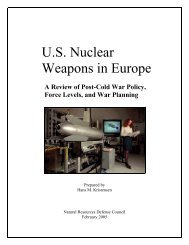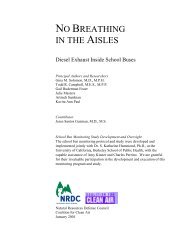p.53-94 (pdf) - Natural Resources Defense Council
p.53-94 (pdf) - Natural Resources Defense Council
p.53-94 (pdf) - Natural Resources Defense Council
You also want an ePaper? Increase the reach of your titles
YUMPU automatically turns print PDFs into web optimized ePapers that Google loves.
Appendix C U.S. Nuclear Weapons, Location Profiles, CONTINUED<br />
LOUISIANA<br />
Rank: No. 9<br />
Nuclear Warheads: 540<br />
Barksdale<br />
AIR FORCE BASE<br />
LOUISIANA ranks 9th in number of nuclear weapons<br />
deployed, a fairly steady rank (7th in 1992 and 9th in<br />
1985). However, Barksdale AFB, south of Bossier<br />
City, has undergone a major change with the closure<br />
of one of the Air Force’s three main nuclear weapons<br />
general depots at the base (the others, at Kirtland AFB<br />
in New Mexico and Nellis AFB in Nevada, remain<br />
open). The 3097th Aviation Depot Squadron, also one<br />
of three major nuclear support units in the Air Force,<br />
was deactivated.<br />
Barksdale was one of six original national stockpile<br />
sites (NSS) storing nuclear weapons for the U.S.<br />
military (called Bossier Base). The former nuclear<br />
weapons storage area (WSA) was initially constructed<br />
by the AEC between 1<strong>94</strong>9 and 1951. Bossier Base<br />
was jointly operated by the AEC, the Armed Forces Special Weapons Project, and Air Force Materiel<br />
Command. The first weapons arrived in 1951. The original complex included three storage buildings<br />
with vaults (“A” structures), a maintenance building (“C” structure), two other assembly/maintenance<br />
buildings, two types of storage igloos, and a dry low-level radioactive waste disposal area.<br />
Barksdale is today the main B-52H bomber base of the Air Force, housing 58 of the service’s 95<br />
planes. The base hosts the largest Air Combat Command bomber wing, the 2d Bomb Wing. Nuclear<br />
weapons stored at Barksdale for use by these bombers include 50 B61-7 and 90 B83 gravity bombs,<br />
300 Air-launched cruise missile (ALCMs), and 100 Advanced Cruise Missiles (ACMs).<br />
The U.S. stock of 1740 nuclear-armed air-launched cruise missiles–ALCMs and ACMs–far exceeds<br />
the number of bombers and most (an estimated 1,040) are in storage in Nevada and New<br />
Mexico. The operational ALCM and ACM stock, we estimate, is split between two B-52 bomber<br />
bases, one northern and one southern. Since the stealthy ACM has a greater ability to penetrate<br />
concerted air defenses, we estimate that more ACMs are stored in the northern base (for earlier<br />
arriving bombers) and more ALCMs are stored at the southern base. Additional B61 and B83 nuclear<br />
gravity bombs, not the normal post-Cold War load for non-penetrating bombers, are also assessed to<br />
be deployed at Barksdale to fulfill the requirements of certain war plans.<br />
The 2nd Bomb Wing received the USAF Nuclear Surety Plaque for 1993 for “distinguished performance.”<br />
Air Combat Command conducted Nuclear Staff Assistance Visits (NSAVs) in June 19<strong>94</strong> and<br />
October 1995. The Wing and its subordinate 2nd Support Squadron again received a USAF Nuclear<br />
Surety Plaque in 1995 for “outstanding achievements” and “contributions” to nuclear security during<br />
their October nuclear mini-inspection. The 2nd Munitions Squadron also received the Safety Award<br />
of Distinction for maintaining “the highest safety standards” with its stock of over 700 air-launched<br />
cruise missiles and B83 bombs. From 16-28 March 1996, the 2nd Wing again underwent a Nuclear<br />
Operational Readiness Inspection (NORI). ACC again provided a Nuclear Staff Assistance Visit in<br />
January 1997.<br />
Worldwide Nuclear Deployments 1998 59
















